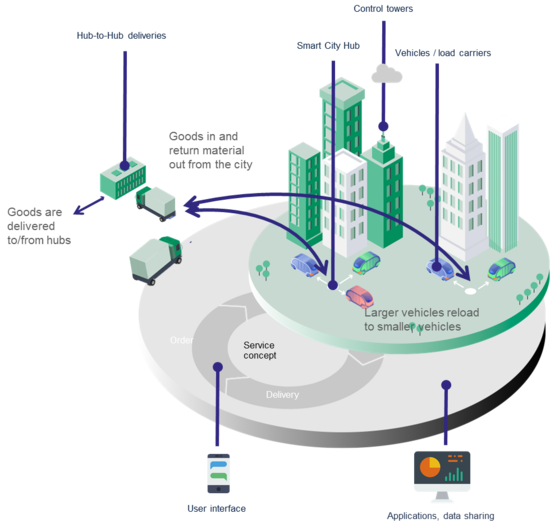HITS 2024

HITS vision is to increase system efficiency in terms of increased use of vehicles and infrastructure. The project aims to accelerate the development of an efficient and sustainable urban freight transport system
Background
Achieving a sustainable society is becoming more complex and requires collaboration between different actors. Digitalisation has provided new business opportunities that change traditional structures. Trends of urbanisation and e-commerce will most likely grow, further strengthened by digital marketplaces and global trade. In the urban environment, logistic systems are already stressed; shippers and carriers are forced to meet increasing customer expectations for speed and flexibility, while having to deal with already troublesome congestion. Therefore, sustainable transportation is an interesting area to conduct research, despite a large number of successful projects related to the subject, the transition towards a sustainable transport system is too slow.
Aim
HITS vision is to increase system efficiency in terms of increased use of vehicles and infrastructure in space and time, based on the sustainability challenges of the urban environments. Therefore, the goal of the initiative is to accelerate the development of an efficient and sustainable urban freight transport system, based on modular bases where the different parts are scalable to an integrated system.
The objective for the first two years of the project (2020-2021) is to build knowledge and understanding of:
- How can sustainable, circular, and efficient urban logistic systems be achieved and scaled up?
(e.g., new vehicle concepts, increased loading factor, optimized return flows, city hubs)- What are the desirable conditions for automation and digitalisation for the different concepts?
- How should a smart and sustainable city hub be designed?
- How should sustainable business models look like?
- How can digitalisation, open APIs and data sharing increase flow efficiency?
The knowledge created in the first two years is used to understand how to scale up a concept and create the conditions to take it a step further, towards the demonstration of a sustainable urban freight transport to the next phase of the project (second two years, 2022-2024).
Methodology
To achieve the objectives, different approaches and methodologies are taken.
- Simulate, analyse, and explore. Describe, analyse, and simulate the system effects to generate the necessary knowledge.
- Open innovation. Invite other players to innovate together with the partners.
- Design thinking. Ensure that the value for the customer is understood and realised.
- Re-design and develop (Re-Make, Re-Value, and Re-Learn). Develop and scale up through the insights generated from the previous analysis.
Expected results
The project promotes horizontal collaboration between different industries and authorities thanks to the mix of project partners, while promoting also cross-sectoral collaboration. The project increases the capacity for innovation in the field at a system level.
The expected deliverables are: i) new knowledge in the field of sustainable urban freight transport systems, ii) strengthened expertise in the area of sustainable logistics within the consortium, iii) demonstration of challenges and solution of urban freight transportation, together with possibilities and limitations as well as experiences and effects.
ITRL:s role in the project
The ITRL team in the HITS project is composed by researchers that work in with three different levels in the overall project, which are described below.
- Flow-level. Impacts of consolidation on urban transport flows. The aim of the research is to study and analyse the impacts of consolidation of urban transport flows. A new vehicle type - multi-purpose vehicles - utilize exchangeable modules which define the function of that vehicle. For example, a vehicle can transport passengers at the beginning and switch its module to transport freight. The use of the new multi-purpose vehicles is expected to create a more efficient and more sustainable urban transport system. Within this research, the effects of the sequential consolidation on customer service, operator costs and environmental aspects are studied. The analysis is done using heuristic and exact optimization algorithms. A novel vehicle routing problem is formulated as a mixed-integer linear program which accommodates the operational characteristics of the multi-purpose vehicles. The heuristic algorithm to solve the routing problem is based on an adaptive large neighbourhood algorithm*.
- System-level. System level effects of urban freight transport systems. The focus of this research is building knowledge and understanding of the design, implementation and scaling up of sustainable concepts for city logistics. The main methodology used in this work is system dynamics modelling, combined with group model building (a participatory methodology which is indicated to understand background contexts and provide knowledge from different disciplinary backgrounds). This methodology allows to take a system level perspective, modelling the system with its dynamics and considering the feedbacks already in the system.
- Meso-level. Collaborative design for business model innovation in servitization. The research aims to develop knowledge on the use of collaborative design that foster and promote business model innovation in the field of sustainable transport systems. Through the use of collaborative design methods, the project will investigate the collaboration within the innovation ecosystem as well as support the innovation activities towards business model innovation through various prototypes and immersive engagements with the stakeholders and society. The expected results are in the form of insights both in the form of academic knowledge on the use of collaborative design methods for business model innovation for servitization and the support of the HITS2024 project with direct empirical research to support the innovation.
Results
- [Report] HITS 2024 Final report (pdf 1.4 MB)
- [Webinar] Sustainable Integrated Urban Freight: Research from the HITS project
- [Webinar] HITS Research Webinar on Sustainable Urban Logistics
References
* S. Ropke and D. Pisinger, “An Adaptive Large Neighborhood Search Heuristic for the Pickup and Delivery Problem with Time Windows,” Transportation Science, vol. 40, no. 4, pp. 455–472, Jan. 2006, doi: 10.1287/trsc.1050.0135.

